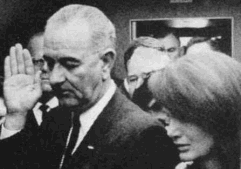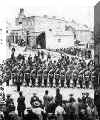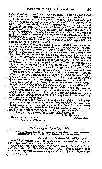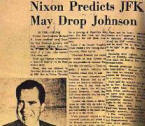 |
||
| In a television interview, A
Current Affair, the mistress of Lyndon Johnson,
Madeleine Brown, described the meeting of 21st November, 1963, when
she was at the home of
Clint Murchison. Others at the meeting included
Harold L. Hunt,
J. Edgar Hoover,
Clyde Tolson,
John J. McCloy and
Richard Nixon. At the end of the evening
Lyndon B. Johnson arrived... "Tension filled the room upon his arrival. The group immediately went behind closed doors. A short time later Lyndon, anxious and red-faced, reappeared... Squeezing my hand so hard, it felt crushed from the pressure, he spoke with a grating whisper, a quiet growl, into my ear, not a love message, but one I'll always remember: "After tomorrow those goddamn Kennedys will never embarrass me again - that's no threat - that's a promise.". It's important to note that John J. McCloy was a member of the now discredited Warren Commission which "investigated" the assassination, appointed by none other than Johnson. Nixon himself was in Dallas on the day of the assassination.
The lead prosecutor in this so called investigation is Sen Arlen Specter. Today, he is Chairman of the Senate Judiciary Committee, insuring that while he is alive, the miscarriage of justice perpetrated on an American president will never be addressed. |
 Scottish Rite Ambassadors for the Confederacy
Scottish Rite Ambassadors for the Confederacy
The Two Confederates for Whom England Threatened War with the Union
LEFT to RIGHT: James M. Mason, John Slidell
 The Threatened Three Front War
The Threatened Three Front War
Up to that time, the North had faced a series of crushing defeats and no significant victories-- e.g. The Battle of Bull Run in July of 1861, and the first great battle, Shiloh, in April of 1862. Pictured here are volunteer regiment of Elora, Ontario, May 1862. By 1870, the active militia numbered over 30,000 to defend against "threats" from the United States.
The photo of Canadian volunteers above was taken the following month, when victory seemed all but certain for the South.
 Union Account of the Boarding of the Trent
Union Account of the Boarding of the Trent
Captain Charles Wilkes' account of the arrest of two Confederate traitors and Scottish Rite freemasons, James Murray Mason and John Slidell. Still at the height of power, pro-slavery factions in England and America hoped to use this incident as a pretext to side with the Confederacy for a three front war. John Slidell, freed through British intervention, would later be implicated as a key conspirator in the Lincoln assassination before fleeing to Europe. (Click image for full gif image inventory.)
"Neutral" England, the Arsenal of the South
 A British warship armed to challenge Northern sovereignty. The Edgar Cecil, loading cannon at Halifax. During the American Civil War the city's military reached 18,000, the Canadian militia was put on alert; England announced that it would defend its colonies with all its power and sent 14,000 officers and men as reinforcements. Not counting a Royal Navy then strong enough to ignore the Union blockade of the South, this alone put 32,000 men at Confederate disposal. (The Union was having enough trouble with blockade runners.)
A British warship armed to challenge Northern sovereignty. The Edgar Cecil, loading cannon at Halifax. During the American Civil War the city's military reached 18,000, the Canadian militia was put on alert; England announced that it would defend its colonies with all its power and sent 14,000 officers and men as reinforcements. Not counting a Royal Navy then strong enough to ignore the Union blockade of the South, this alone put 32,000 men at Confederate disposal. (The Union was having enough trouble with blockade runners.)
 LEFT: A British blockade runner. They were the fastest vessels of their day, and arrived "with the regularity of express trains." They timed their departures to arrive at night, their most common route from English colonies in Nassau (the Bahamas) and Bermuda; traveling directly to their destination, Confederate ports.
LEFT: A British blockade runner. They were the fastest vessels of their day, and arrived "with the regularity of express trains." They timed their departures to arrive at night, their most common route from English colonies in Nassau (the Bahamas) and Bermuda; traveling directly to their destination, Confederate ports.
"At the beginning of the war the Union blockade of Southern ports was not effective, because the North lacked ships to make it so. Blockade-runners, mainly British, made fortunes by landing cargoes of munitions and scarce goods at Southern ports...
"Although the Confederacy had no navy, it still found ways to cripple Northern commerce. In spite of its lack of shipyards, it managed to equip a number of ships for service at sea. It also ordered the construction or purchase of other ships in England. Over the protests of the Union government, three English-built ships, the Florida, the Alabama, and the Shenandoah, were delivered to Confederate naval officers and given the task of destroying the U.S. merchant fleet. These three raiders alone inflicted damage estimated at $16.6 million on Union shipping. The loss, while serious, was trivial in comparison to the effect of the Union blockade on the Southern economy..." *
Since the beginning of the war, the Confederacy had had a naval officer, James D. Bulloch, in Britain to buy or contract for cruisers to raid Northern commerce. In 1861 and 1862, Bulloch had managed to acquire and equip several Confederate ships.
If the United States were to supply warships and arms to the I.R.A. today, in equal proportion to that supplied by the British to the South in the Civil e South in the Civil War, one could only imagine the fate of England and Ireland today. And would historians dare care us neutral?
Gettysburg-- a battle so massive the fighting encompassed over 25 square miles. Pictured below are Union dead. This battle, a failed invasion of the North, was Gen. Lee's most earnest attempt to secure sovereign status for the Confederacy. By proving the North could be defeated on its own ground, Lee hoped he could woo full-scale, pro-Confederate intervention by foreign states, particularly Britain.
nbsp; Britain.

